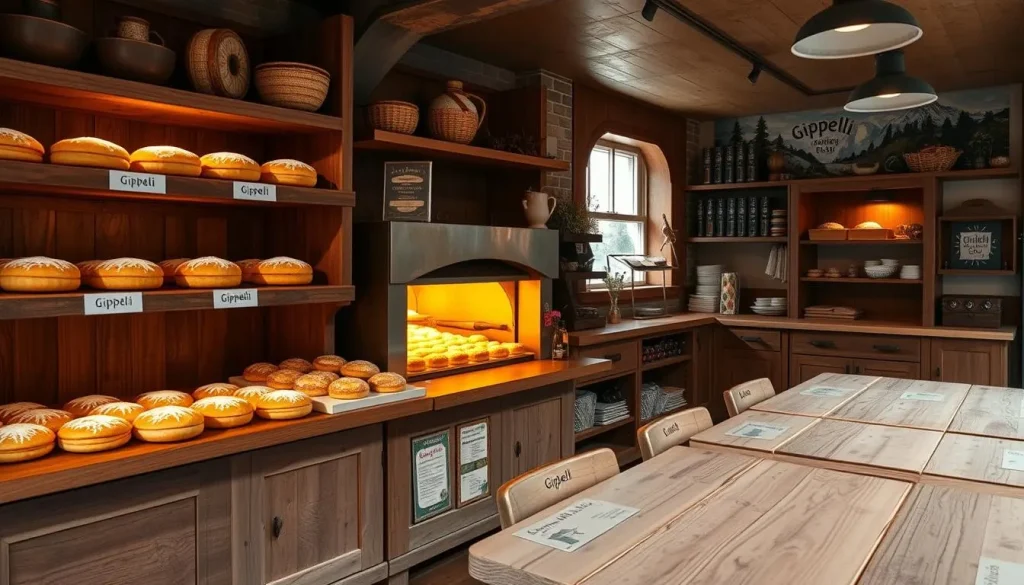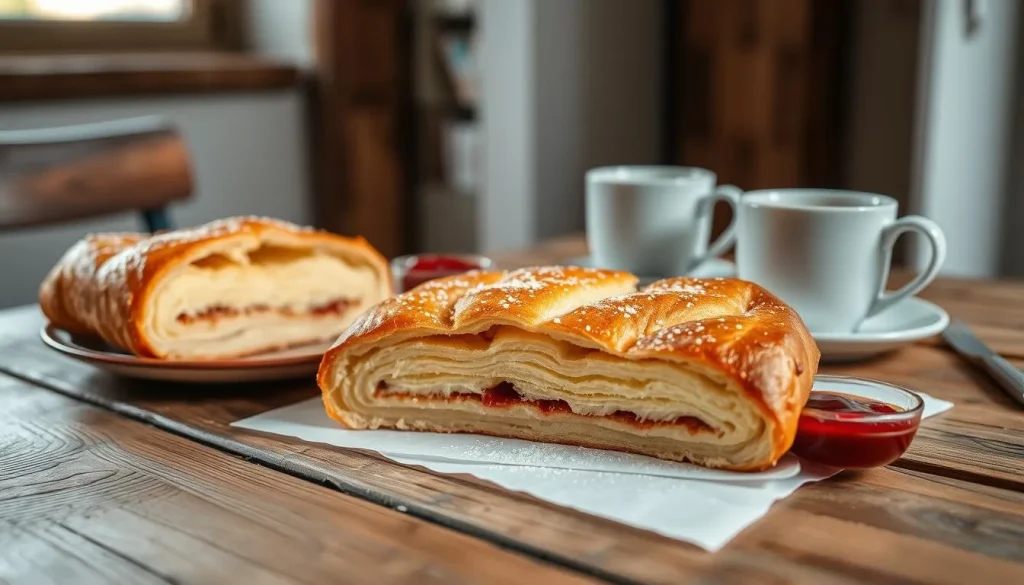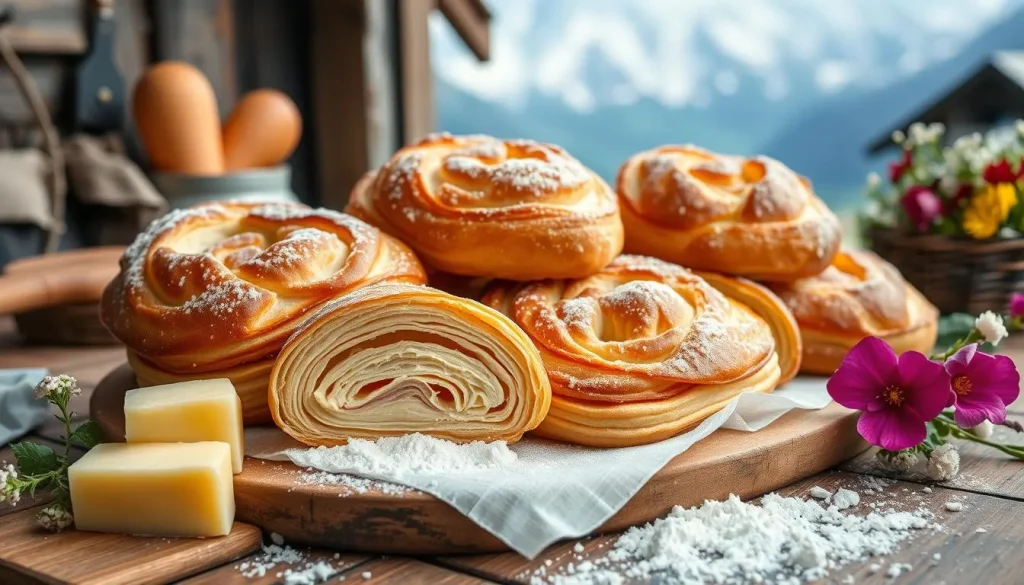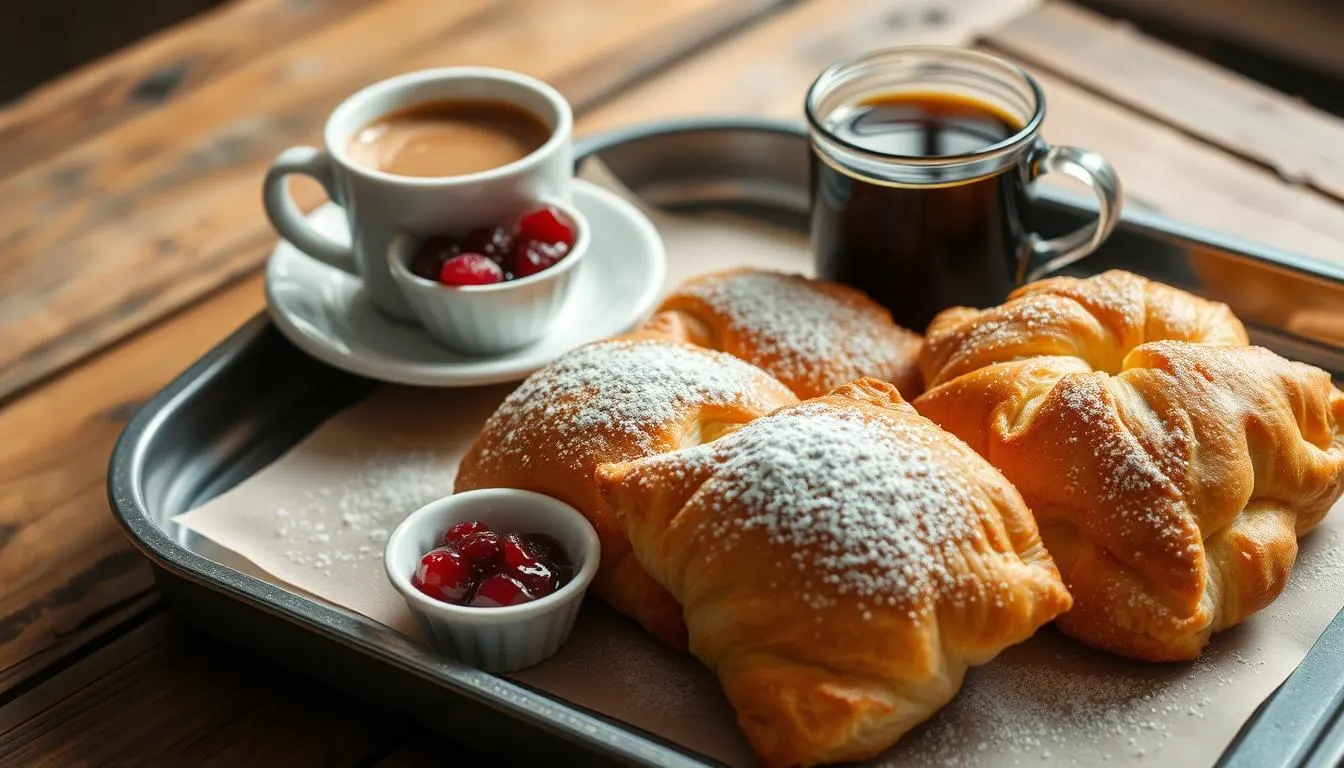As the sun rises in Switzerland, the smell of fresh pastries fills the air. It invites you to try a taste of Switzerland’s rich food culture. The gipfeli, a flaky and buttery breakfast treat, is a favorite among both locals and visitors.
We will dive into making the perfect Gipfeli Recipe. This Swiss pastry is like a croissant but with unique flavors and textures. We’ll cover its history, cultural importance, and how to make this traditional Gipfeli Recipe at home.
Main Highlights
- Gipfeli are a traditional Swiss breakfast pastry with a flaky, buttery texture and slightly sweet flavor.
- The recipe requires high-quality ingredients, including all-purpose flour, warm milk, sugar, yeast, salt, and cold unsalted butter.
- Proper technique, such as the lamination process and precise shaping, is crucial for achieving the signature gipfeli appearance and layers.
- Baking at the right temperature and time is essential for perfectly cooked, flaky gipfeli pastries.
- Gipfeli can be enjoyed plain or with a variety of fillings and toppings, making them a versatile breakfast or snack option.
Introduction to the Gipfeli Recipe: History and Cultural Heritage
The Swiss gipfeli is a favorite breakfast treat. It has a long history and is deeply rooted in Swiss culture. These flaky, crescent-shaped pastries have been around since the late 19th century. They came from the Austrian kipferl.
Origins of the Swiss Gipfeli Recipe: Breakfast Pastries
The Swiss gipfeli started in the 19th century. Austrian baker August Zang brought the kipferl to Paris. This led to the famous French croissant.
But Swiss bakers made their own version. They made it more compact, flaky, and less sweet. This became a key part of Swiss breakfast.
The Cultural Significance of the Gipfeli Recipe in Swiss Cuisine
The gipfeli is more than a pastry in Switzerland. It’s a cherished part of their culinary history. Swiss families love to have gipfeli for breakfast or as a snack.
They enjoy it with coffee, tea, or hot chocolate. These pastries symbolize Swiss hospitality and the joy of a perfect morning.
The Evolution of the Traditional Gipfeli Recipe
The Gipfeli Recipe has evolved over time. Each region and bakery has its own special version, but the essence of a good Gipfeli Recipe remains consistent. You can find wholegrain gipfeli or ones filled with sweet treats.
This shows the diversity and pride of Swiss baking. Even with all the changes, the gipfeli remains a flaky, buttery delight. It represents the love for quality and tradition in Swiss cooking.

Understanding the Difference Between the Gipfeli Recipe and French Croissants
The swiss croissant recipe and swiss viennoiserie are similar but different. The Swiss Gipfeli is a breakfast pastry known for its flaky texture. It’s different from the French croissant.
Gipfeli has 18-22% butter, while French croissants have 25-30%. This means Gipfeli tastes richer and feels denser.
Gipfeli are shaped like a crescent moon. French croissants are straight with curved ends. This shape makes Gipfeli look and feel special.
Gipfeli get an egg wash before baking. This gives them a golden shine. Croissants don’t need this step.
Gipfeli proof for about 1 hour. Croissants need up to 2 hours. Gipfeli bake at 375°F, while croissants bake at 400°F.
Both Gipfeli and croissants are flaky and buttery. But Gipfeli’s unique flavors and methods make it special. It’s a key part of Swiss food culture.

Essential Ingredients for the Best Gipfeli Recipe
To make a delicious Gipfeli Recipe, or flaky Swiss pastries, you need the right ingredients. The swiss butter braid recipe and premium all-purpose flour are key. Each part is important for the pastry’s texture and taste.
High-Quality Butter Selection for the Perfect Gipfeli Recipe
The best Gipfeli starts with the butter. Choose a butter with 82-84% fat. This makes the dough flaky and buttery. European-style or cultured butters taste richer.
Flour and Yeast Requirements for Your Gipfeli Recipe
All-purpose flour is best for Gipfeli. It gives the pastry structure and chewiness. Use high-quality, unbleached flour. Also, fresh or active dry yeast is needed for the dough to rise.
Additional Key Components for a Flaky Gipfeli Recipe
- Granulated sugar: Adds subtle sweetness to balance the salty and savory notes.
- Salt: Enhances the overall flavor profile and balances the sweetness.
- Milk (optional): Can be incorporated to create a softer, more tender crumb.
- Eggs (optional): Contributes to the rich, tender texture and golden-brown color.
With the right ingredients, you can make the perfect swiss butter braid recipe and flaky swiss pastry at home.

Kitchen Equipment and Tools Needed
To make the perfect swiss bakery treats, like swiss puff pastry recipe Gipfeli, you need the right tools. From mixing bowls to baking sheets, each tool is key for success. Let’s look at what you need for baking Gipfeli.
You’ll start with high-quality mixing bowls for dough prep. Don’t forget measuring cups and spoons for exact ingredient amounts. For example, you’ll need 500 grams of flour and 250 grams of cold butter.
A rolling pin is crucial for lamination, making the dough flaky and buttery. If you don’t have a rolling pin, a clean bottle works too.
| Essential Equipment | Quantity |
|---|---|
| Mixing Bowls | 2-3 |
| Measuring Cups and Spoons | 1 set |
| Rolling Pin | 1 |
| Baking Sheets | 2-3 |
| Parchment Paper | 1 roll |
| Pastry Brush | 1 |
| Plastic Wrap | 1 roll |
| Damp Cloth | 1 |
Baking sheets are vital for shaping and baking Gipfeli. Parchment paper ensures even baking and easy pastry release. A pastry brush is needed for the egg wash, which makes the pastries golden. Plastic wrap and a damp cloth help with dough resting and lamination.
With these tools, you’re ready to make delicious swiss bakery swiss puff pastry recipe Gipfeli at home.
Step-by-Step Gipfeli Dough Preparation
Making the perfect Gipfeli Recipe starts with the dough. This process is key for getting the flaky, light, and buttery texture. It’s what makes gipfeli different from the French croissant.
Initial Dough Mixing for the Gipfeli Recipe
Begin by mixing 4 cups of bread flour, 2 teaspoons of yeast, and 2 teaspoons of salt in a big bowl. Add 1 cup of warm water and 3 tablespoons of melted butter. Knead the dough for 10 minutes until it’s smooth and elastic. Then, cover it and let it rest for 1 hour to activate the yeast.
Mastering the Lamination Process for the Gipfeli Recipe
The lamination process is what makes gipfeli’s layers. Roll the dough into a big rectangle and fold it in thirds like a letter. Turn it 90 degrees and fold it again. Chill it for 30 minutes to 24 hours before doing it twice more.
Resting and Chilling Phases for Flaky Gipfeli
After the last lamination, let the dough rest at room temperature for 30 minutes. This makes the dough easier to shape. Then, chill it for another 30 minutes to 24 hours before baking the swiss crescent roll recipe.
The dough’s resting and chilling phases are very important. During this time, consider preparing our Chicken Breast Recipes to pair a savory dish with your sweet Gipfeli for a balanced meal. They help create the light, flaky layers that give Swiss gipfeli its unique taste and texture.
Mastering the Art of Shaping Gipfeli
Making perfect Swiss gipfeli is more than just the dough. It’s about the art of shaping. The crescent shape comes from careful rolling and cutting. This shows the heart of Swiss baking.
Start by rolling out the dough into a 20×40 cm rectangle. Use a sharp knife or cutter to cut it into triangles. Make sure the cuts are clean and even. This is key for the gipfeli‘s shape and look.
Roll each triangle from the wide end to the tip. Roll gently to keep the dough flaky. Pay attention to how the seams line up for a smooth look.
Place the shaped gipfeli on a baking sheet lined with parchment. Leave enough space for them to expand while baking. This helps them rise and get flaky.
After shaping, the gipfeli are ready for proofing and baking. This is when they truly come to life. By mastering shaping, you’ll make gipfeli that look great and taste amazing. They’ll be a hit in any Swiss breakfast.
Baking Techniques for Perfect Flaky Layers
Making the perfect swiss puff pastry recipe or flaky swiss pastry needs careful temperature control and timing. It’s key to get the golden-brown crust and flaky layers that Swiss Gipfeli are known for.
Temperature Control
To bake Gipfeli, the oven must be preheated to 400°F (200°C). This high temperature is vital for the swiss puff pastry recipe to rise well and get a flaky exterior. Brush the shaped pastries with egg or milk wash before baking. This makes the crust shiny and crisp.
Timing and Visual Cues
Gipfeli need close watching during baking, as they bake in 15-20 minutes. It’s important to avoid over-browning, which can ruin the texture. They’re done when they’ve risen and turned golden-brown.
Getting the hang of temperature control and timing is key for baking flaky swiss pastry with perfect layers. By keeping an eye on the oven temperature and baking time, home bakers can get results as good as Swiss bakeries.
“The secret to flaky, buttery Gipfeli lies in the perfect marriage of temperature and time.”
Traditional Swiss Serving Suggestions and Pairings
The Swiss breakfast pastry, Gipfeli, is best served warm. It’s often dusted with powdered sugar or enjoyed with various toppings. These flaky, golden treats are perfect for a morning pick-me-up or a filling meal.
A classic choice is to pair Gipfeli with chilled orange juice or a strong coffee. The sweet pastry and the juice’s acidity or the coffee’s bold flavors make for a great start to the day.
For a more filling breakfast, try Gipfeli with scrambled eggs, cheeses, or fresh fruits. These Swiss bakery treats are versatile. They can be customized to fit your taste and dietary needs.
| Pairing Suggestions | Flavor Profile |
|---|---|
| Milk | Classic, comforting |
| Fruit Smoothies | Refreshing, nutritious |
| Jams and Spreads | Sweet, indulgent |
| Scrambled Eggs | Savory, protein-rich |
| Cheese Platters | Sophisticated, artisanal |
Whether you like your Gipfeli with powdered sugar or with your favorite toppings, these Swiss breakfast pastries are a joy to eat. They offer a delightful and flexible culinary experience.
Storage Tips and Reheating Methods
Keeping your homemade gipfeli flaky and tasty is key. With the right storage and reheating, you can enjoy them for days. This way, you can relish your Swiss pastries whenever you want.
Proper Storage Techniques
You can make gipfeli ahead of time. Just stop at the shaping step. Then, cover them with plastic wrap and chill in the fridge overnight. Before baking, let them warm up to room temperature.
To store them longer, freeze the shaped pastries. Put them on a baking sheet and freeze until firm. Then, move them to a sealed bag or container. To bake, thaw them at room temperature first.
Best Practices for Reheating
Reheat your gipfeli gently to keep them crispy and flaky. Reheating times range from 30 seconds in the microwave to 3-10 minutes in the oven or air fryer. It depends on your appliance and how many you’re reheating.
Thaw frozen gipfeli in the fridge overnight for the best results. This avoids a doughy interior. When reheating, don’t overdo it to prevent the pastry from getting tough.
| Appliance | Reheating Time | Temperature |
|---|---|---|
| Microwave | 30 seconds | – |
| Oven | 3-10 minutes | 325°F (163°C) |
| Air Fryer | 3-10 minutes | 325°F (163°C) |
| Toaster Oven | 3-10 minutes | 325°F (163°C) |
By using these storage and reheating tips, you can enjoy homemade gipfeli days after baking. They become a convenient and tasty treat to have around.
Conclusion
The Swiss Gipfeli recipe is a treasure from Switzerland’s rich food history. It mixes the flakiness of a croissant with a Swiss twist. Now, home bakers can make these beloved breakfast treats in their own kitchens.
Making Gipfeli is a fun and tasty journey. It starts with preparing the dough and ends with baking. With the right steps, anyone can make these flaky, golden pastries. They are perfect for a cozy Swiss cafe feel.
Enjoying gipfeli as a weekend breakfast or afternoon snack is a treat. This gipfeli recipe lets home bakers enjoy the flaky swiss pastry taste. It’s a way to share the joy of Swiss baking with loved ones.
FAQ
What are Gipfeli?
Gipfeli are tasty Swiss pastries like croissants but with their own twist. They’re made from flour, sugar, salt, yeast, warm milk, cold butter, and egg. They taste slightly sweet and are crispy yet soft.
What is the origin and cultural significance of Gipfeli?
Gipfeli started in the 19th century in Switzerland. Swiss bakers made a special dough that became a Swiss breakfast staple. Each place and bakery added their own touch, showing Swiss pride in baking.
Gipfeli show Switzerland’s love for quality and tradition. They represent Swiss hospitality and the charm of a perfect breakfast pastry.
How are Gipfeli different from French croissants?
Gipfeli are similar to French croissants but have their own special qualities. They are more compact, flaky, and less sweet. Gipfeli have a denser texture and more butter, making them richer in taste.
What are the key ingredients for making Gipfeli?
Making Gipfeli needs high-quality butter, premium flour, sugar, salt, and yeast. The right mix and quality of these ingredients are key for the perfect taste and texture.
What kitchen equipment is needed to make Gipfeli?
You’ll need mixing bowls, measuring cups and spoons, a rolling pin, baking sheets, and parchment paper. A pastry brush, plastic wrap, and a damp cloth are also essential. You can use a silicone mat instead of parchment paper, and a clean bottle as a rolling pin.
How is the Gipfeli dough prepared?
Preparing the dough involves mixing dry ingredients, adding warm water and yeast, and kneading for 10 minutes. Then, rest for an hour. The dough is rolled, folded, and chilled three times to get the flaky texture.
How are Gipfeli shaped?
To shape Gipfeli, roll out the dough into a rectangle and cut into triangles. Roll each triangle from the wide end to the tip to get the crescent shape. Use a sharp knife for clean edges.
What are the key steps for baking Gipfeli?
To bake Gipfeli, preheat the oven to 400°F (200°C). While you wait, explore how our Irish Trash Can Cocktail can add a fun and colorful touch to your breakfast spread. Brush the shaped pastries with egg or milk for a shiny crust. Bake for 15-20 minutes. Proper temperature and timing are key for the flaky layers and golden crust.
How are Gipfeli traditionally served and enjoyed?
Gipfeli are best served warm, often with powdered sugar or jam. Enjoy with milk, orange juice, or coffee for breakfast. They pair well with scrambled eggs, cheese, or fruit, or with spreads like Nutella or butter.
For a refreshing drink option, try our Skinny Margarita Recipe, which pairs surprisingly well with buttery pastries like Gipfeli.
How can Gipfeli be prepared and stored ahead of time?
Gipfeli can be made ahead by shaping and letting them rise in the fridge overnight. Unbaked Gipfeli can be frozen for longer storage. Thawed Gipfeli can be baked, and frozen ones warmed in the oven to stay crispy.

Gipfeli
Equipment
- Mixing bowl (notes: large)
- Rolling Pin
- Baking sheet (notes: lined with parchment)
- Pastry brush
Ingredients
- 2 cups All-purpose flour
- 1/2 tsp Salt
- 1 tbsp Sugar
- 1/4 cup Unsalted butter notes: chilled and cubed
- 1/2 cup Milk notes: warm
- 1 packet Active dry yeast notes: about 2 1/4 tsp
- 1 Egg yolk notes: for egg wash
Instructions
- In a mixing bowl, combine flour, salt, and sugar.
- Add the cubed butter and rub it into the flour until the mixture resembles coarse crumbs.
- Dissolve yeast in warm milk and let it sit for 5 minutes.
- Gradually add the yeast mixture to the dry ingredients, mixing until a dough forms.
- Knead the dough on a floured surface for 5-7 minutes until smooth.
- Roll the dough into a large rectangle and cut it into triangles.
- Roll each triangle from the wide end to the tip to form crescent shapes.
- Place the crescents on a baking sheet, cover, and let rise for 20 minutes.
- Preheat the oven to 375°F.
- Brush the crescents with egg yolk for a shiny finish.
- Bake for 18-20 minutes until golden brown.

This Gipfeli recipe looks amazing! I love how detailed the instructions are, especially the lamination process for those flaky layers. Definitely going to try these for breakfast—can’t wait to enjoy them with some homemade jam and coffee. Perfect Swiss vibes!